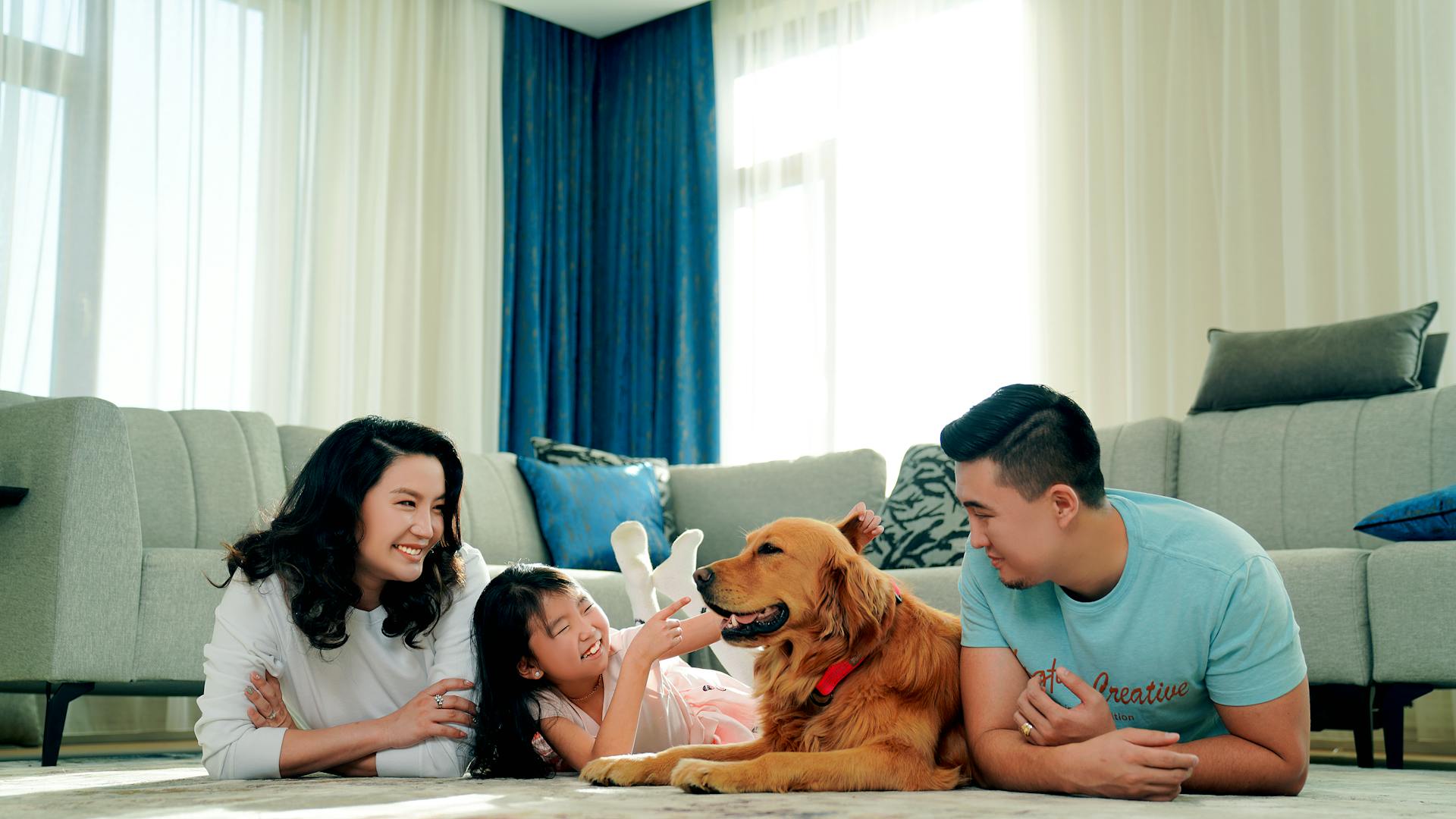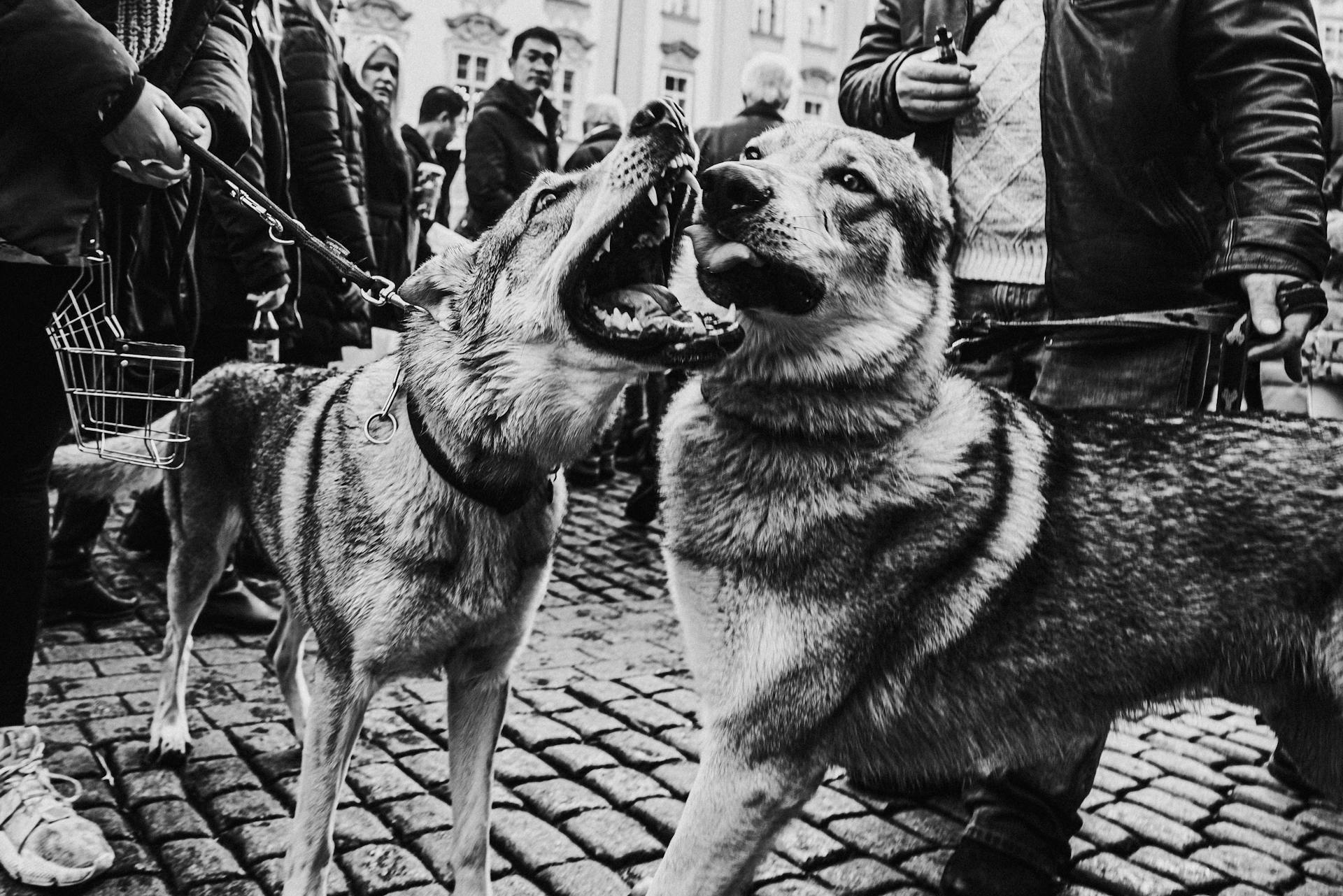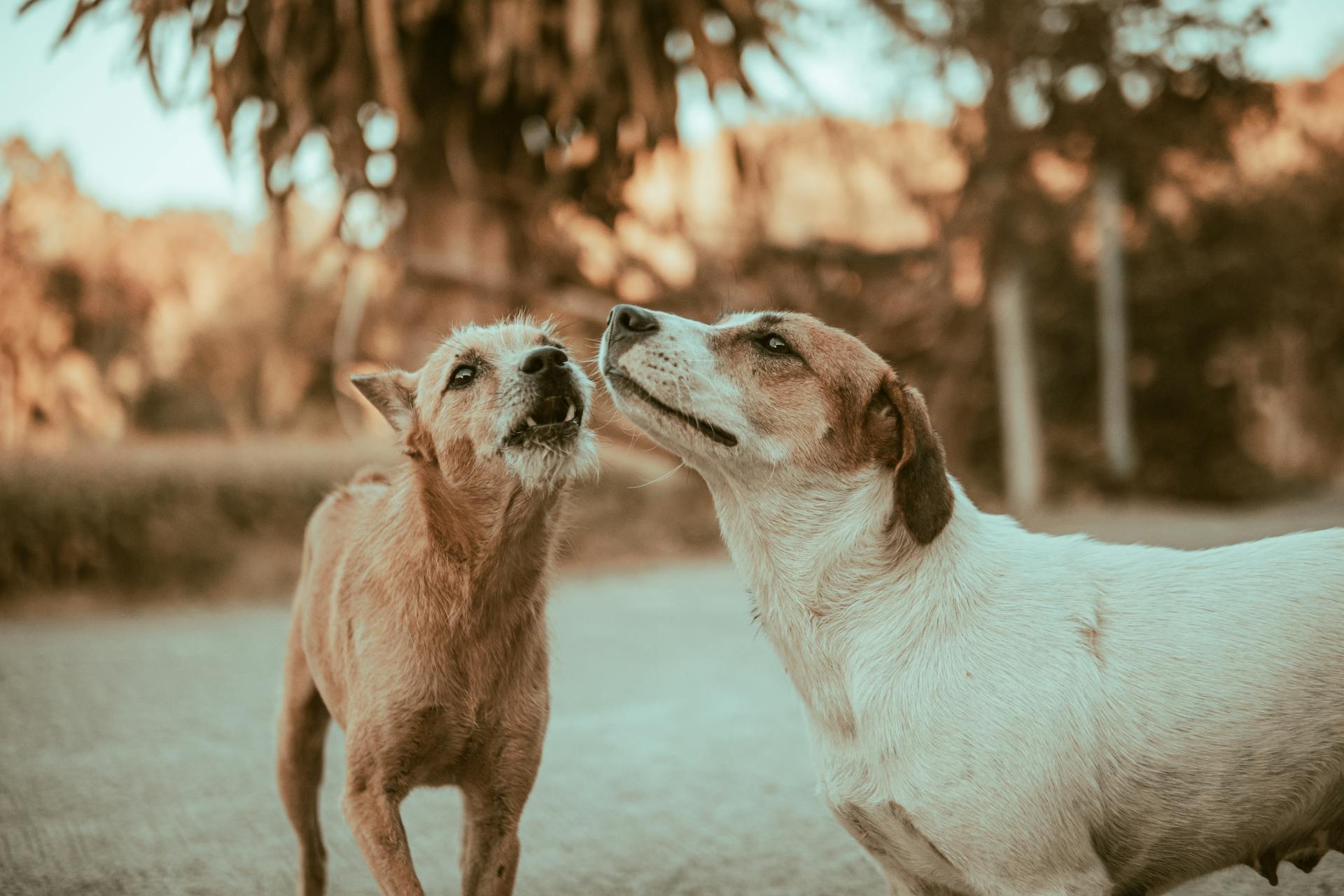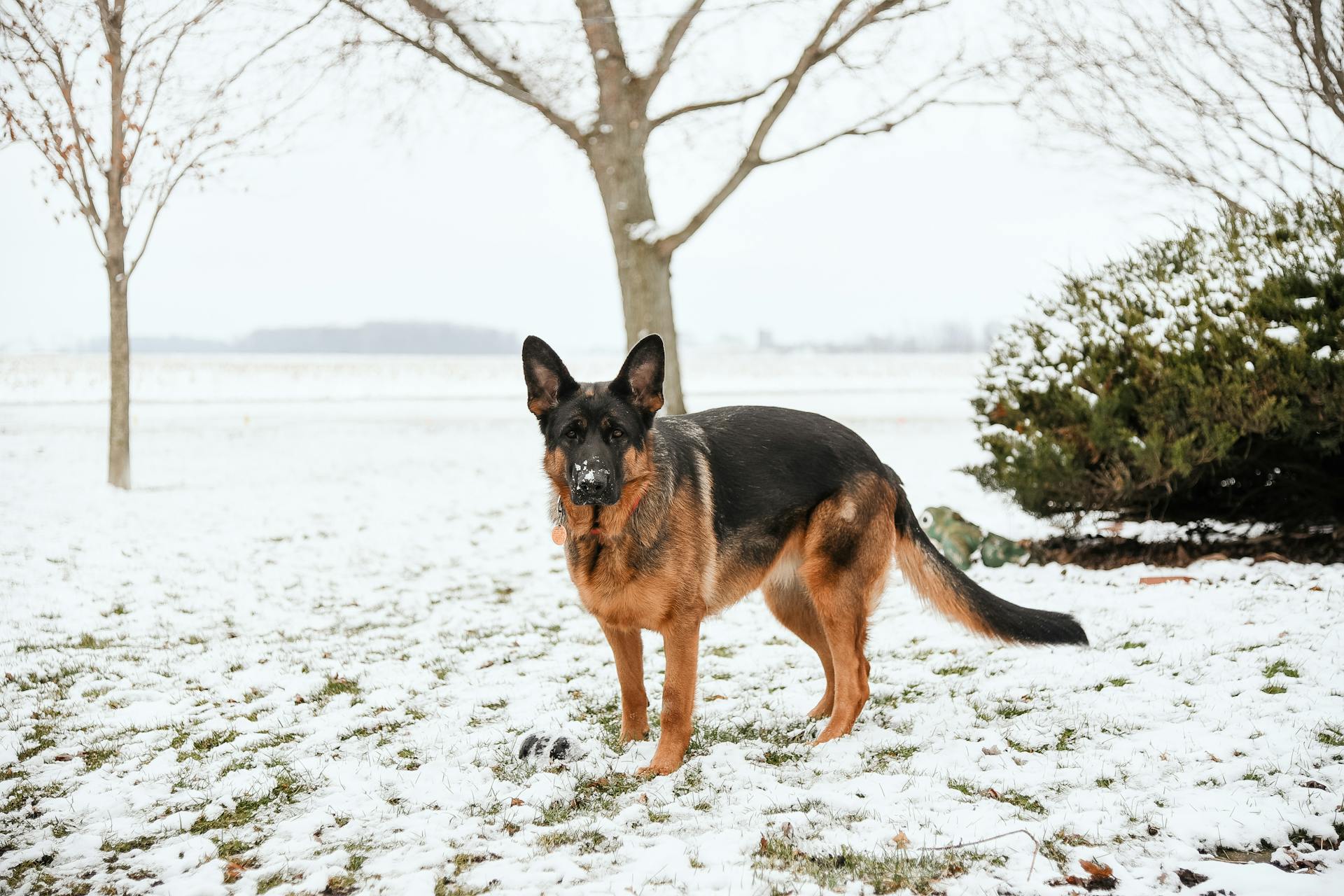
Preventing fights between two male dogs requires a deep understanding of canine behavior and body language.
Male dogs often engage in dominance behaviors, such as raised hackles and stiffened postures.
To prevent fights, it's essential to manage their interactions and create a safe environment.
Spaying or neutering can significantly reduce aggression in male dogs, but it's not a guarantee.
Causes and Prevention
Dogs may become aggressive due to past experiences, such as abuse or neglect, or lack of socialization with other dogs as a puppy.
A traumatic encounter with another dog can also contribute to aggression. For example, a dog rescued from a dog fighting operation may exhibit inter-dog aggression more frequently.
An owner's behavior, such as punishing a more dominant dog, can also influence a manifestation of aggression. This can create tension between dogs, making it harder to stop them from fighting.
Prevention is key, so it's essential to be aware of your dog's cues and the cues of other dogs. If you notice one or more dogs becoming overly aroused or showing signs of aggression, it's time to intervene and separate them.
To prevent dogfights, learn how to tell when a fight is coming and how to prevent it. Use distractions like treats and training to change the dynamic and let the dogs cool off.
Additional reading: Male Dogs Fighting Same Household
Causes

Past experiences, such as abuse and neglect, can be a major cause of aggression in dogs.
Tension over resources is a common trigger for dog aggression, including food, high-value humans, and coveted spots on the sofa.
Social aggression can result when neither dog in a household is willing to defer to the other, making it about deference, not dominance.
Dogs can be notoriously stoic about pain, especially slowly developing arthritis, which can lead to defensively aggressive behavior in anticipation of being hurt by a packmate.
In dog behavior science, dominance is simply about access to a mutually desired resource, not a permanent ranking of one dog over the other.
The more often dogs fight, the more tension there is between them, making it harder to modify their behavior and increasing the likelihood of injuries.
Prevent Resource Guarding
Resource guarding is a common issue that can lead to dogfights and stress. It's natural for dogs to want to protect their resources, but it's up to us to manage their environment to prevent squabbles.
Pick up your dog's food bowls after mealtimes to avoid resource guarding. Provide multiple water bowls, one for each dog plus one extra, to reduce competition.
Dogs may become overly attached to certain chews or toys, so put them in separate areas to avoid squabbles. If you give them chews or bones, separate them immediately to prevent resource guarding.
Removing leftovers can also help prevent resource guarding. If you notice your dogs becoming overly aroused or showing signs of aggression, it's time to intervene and separate them.
Resource guarding can be triggered by more than just food, such as a coveted spot on the sofa or access to a doorway. Be aware of your dog's cues and pay close attention to other dogs' cues to prevent resource guarding.
You might enjoy: How to Stop Dog from Eating Other Dogs Food
Recognizing and Diagnosing
Recognizing the signs of inter-dog aggression is crucial to preventing fights between your two male dogs. The most common symptoms include growling, biting, lip lifting, snapping, and lunging toward another dog.
Before a severe incident occurs, you may notice more discreet signs of social control, such as staring and blocking the other dog's entrance into a room. These behaviors can be subtle, but they're essential to recognize.
If you suspect a neurological condition is causing the aggression, your veterinarian may recommend advanced imaging, like CT or MRI scans, to determine if it's a central nervous system disease or to rule out other underlying conditions.
Symptoms and Types
Recognizing the symptoms of inter-dog aggression is crucial to preventing severe incidents.
Growling, biting, lip lifting, snapping, and lunging toward another dog are common symptoms of inter-dog aggression.
Fearful or submissive body postures can accompany these behaviors, such as crouching, tucking the tail under, licking the lips, and backing away.
Before a severe incident occurs, dogs may exhibit more discreet signs of social control, like staring and blocking the other dog's entrance into a room.
Here's an interesting read: Male Dogs in Heat Symptoms
Diagnosing
Diagnosing aggression in dogs can be tricky because there's no official procedure, but veterinarians look for symptoms that might seem similar to playful behavior.

Some symptoms of inter-dog aggression are very similar to excited, non-aggressive arousal.
Biochemistry and urine analysis usually yield unremarkable results, but if any abnormalities are found, they might help identify an underlying cause for the aggression.
Lab tests often don't provide clear answers, but they can help rule out other health issues.
If a neurological condition is suspected, advanced imaging like CT or MRI scans may be necessary to determine if it's a central nervous system (CNS) disease or to rule out other underlying conditions.
Breaking Up Fights
Breaking up fights between two male dogs requires caution and the right approach. Never physically get in the middle of two dogs fighting or try to grab their collars, as you'll likely get injured.
It's essential to clear the scene first, removing children from the area and keeping crowds of people away. This will help prevent further stress and potential injuries. Ideally, have two people involved in breaking up the fight, with one person holding each dog in a control position.
Consider reading: How to Introduce 2 Male Dogs
To safely intervene, you can use objects strategically, such as throwing a heavy blanket over the dogs to momentarily break their focus. Alternatively, you can try using a long automatic umbrella or placing objects like chairs or laundry baskets on top of the dogs to help separate them. However, these methods may not work well in cases of serious fighting.
If you have access to a break stick, you can use it to release the bite. Insert the pointed end of the break stick behind the dog's front canine teeth and wiggle it in as much as possible, then twist it forward or backward to release the bite.
Clear the Scene
Removing people from the area is crucial in breaking up a fight. Remove children from the scene, as they can be easily hurt.
Crowds of people should be kept away, as they can escalate the situation. It's best if there are two people involved in breaking up the fight, ideally the dogs' owners.
All other people should step far away to avoid getting involved and to prevent further conflict.
For another approach, see: How to Cut Dog's Nails When They Fight You?
Leashed Separation
Leashed separation is a technique used to safely separate dogs in a fight.
Safety first: don't use this method for bite-hold fights, as it can make things worse.
Grab a slip lead and loop it over the dog's neck or around their body in front of their hind legs if you don't already have a leash attached.
If you're alone, pull one dog away and secure it to a fence or post before pulling the other dog away and separating.
This technique comes with a risk of redirected bites, where a dog turns to bite the person when they can no longer get to the other dog.
Use a Break Stick
Using a break stick is a great way to break up a dogfight without getting hurt. You can try to use a break stick by inserting the pointed end behind the dog's front canine teeth, where there's a natural gap.
Don't try to fit the break stick between the back molars, as there's not enough space. Insert the stick as far as you can, then wiggle it in to loosen the bite.
Twist the break stick forward or backward to release the bite, kind of like revving a motorcycle engine. This will cause the dog's mouth to open, giving you an opportunity to move them away from each other.
Ideally, there should be at least two people involved when using a break stick, one to hold the victim dog in the control position and another to hold the aggressing dog. Having a third person to use the break stick is even better, as they can focus on releasing the bite while the others control the dogs.
Handling and Training
Develop a training plan to address the fighting between your two male dogs. This plan should include management options, counterconditioning, and desensitization to help them feel more comfortable around each other.
Consult a qualified trainer or behaviorist who specializes in positive reinforcement methods to help you create a customized training plan.
To manage interactions, use baby gates or play pens to keep your dogs apart and provide them with their own spaces and resources. This is especially important when introducing a new puppy to an existing dog.
Training basic obedience cues like sit, down, or leave it can help strengthen your bond with your dogs and reduce the likelihood of fights.
Manage Interactions
Managing interactions between dogs in the same household can be a challenging task, especially if they're not getting along. Supervising and managing interactions is crucial to prevent fights and create a harmonious environment.
Consider using baby gates or play pens to keep them apart, especially if they're new to each other. This will give them their own space and prevent conflicts.
It's essential to keep them separated until they've calmed down or during training sessions. This will help prevent any further aggression and allow you to work on their behavior.
If you have a puppy introducing them to a new dog, it's best to keep them separated until they're both comfortable with each other's presence. Reading our full guide to introducing your puppy to a dog can provide you with valuable information on how to do this safely.
Here are some additional tips for managing interactions:
- Provide each dog with their own bed or mat in the same room to show them that nice things happen when they're in the presence of each other.
- Teach them to lie down in their respective beds or mats, and practice in the same room, building up duration as you go.
- Make sure they have their "own" bed that the other one doesn't get into and that they're both the same distance from you to prevent any concerns about sharing.
By following these tips, you can create a safe and harmonious environment for your dogs to interact with each other.
Disassembling a Kit

If you ever need to disassemble a dog fight kit, keep in mind that a large facility should have a kit easily accessible in each area.
First, locate the kit, which is recommended for facilities like shelters, veterinary clinics, or dog daycare where multiple dogs interact.
The kit should be easily accessible, ideally in a central location where it can be quickly grabbed in case of an emergency.
In a shelter or rescue setting, having a fight kit in each area can help prevent injuries and keep the environment calm.
A different take: Why Does My Male Dog Keep Licking My Female Dog
What to Keep in Your Kit
When handling and training animals, it's essential to have the right tools in your kit. A water spray bottle can be a lifesaver in situations where an animal is getting too excited or aggressive.
Slip leashes are a must-have for any animal handler. They allow for quick and safe restraint of an animal.
A carabiner can be attached to fences or around posts, and can also be used to attach leashes to your dog's leash handle or clipped on your treat pouch belt.

Deterrent sprays, such as Spray Shield, can be used to calm an animal in a stressful situation.
A break stick is a useful tool to have in your kit, especially when working with strong or aggressive animals.
A sorting board, also known as a Pig board or Livestock board, can be used to sort and manage animals in a safe and efficient manner.
Here are some essential items to include in your kit:
- Slip leashes
- Water spray bottle
- Carabiner
- Deterrent sprays (such as Spray Shield)
- Break stick
- Sorting board (a.k.a. Pig board, Livestock board)
Hands-Off Techniques
Hands-off techniques are crucial in breaking up a dog fight without putting yourself or the dogs at risk.
Some tools, like aversives, are not suitable for dog training or behavior modification, so it's best to use them only in case of an emergency after a fight has started.
What to Do Next
After a dog fight, it's essential to separate the dogs immediately in their own secure areas. This allows you to evaluate whether either or both dogs need veterinary care.
Any puncture wounds, even small ones, or lacerations in the skin require veterinary care as soon as possible to prevent infection. If the puncture is not bleeding profusely, you can try to flush and bandage it yourself, but it's still a good idea to have your regular veterinarian check it out.
Mild abrasions can be treated at home, but follow proper wound care to ensure they heal properly. This means keeping the area clean, applying antibiotic ointment, and covering it with a bandage.
If the area doesn't begin to show improvement within a couple of days or worsens, seek veterinary care. You should also watch for signs of infection, such as pain, swelling, warmth, or moisture.
If you or anyone else has sustained injuries while breaking up a dog fight, seek immediate medical attention, especially if you're immunocompromised. This is because dog bites can be a high-risk area for infection, and you'll need proof of a rabies vaccine for the dog involved.
After the immediate medical attention, take some time to assess the situation and remove any items that may have triggered the fight. This will help prevent future altercations.
It's also a good idea to consider changing management strategies to prevent future fights. This might involve separating the dogs for a while, especially if the fight was intense. Allow them time to decompress and for the stress chemical cortisol in their bodies to return to normal levels.
Pay attention to their body language and behavior when you reintroduce them. If they seem on edge or worried about each other's presence, it's best to keep them separate and consult a certified canine behavior consultant for support.
Frequently Asked Questions
How to get two dogs to get along when one is aggressive?
To get two dogs to get along when one is aggressive, start by choosing a neutral location and introducing them in stages, while also practicing obedience training and working with a professional animal behaviorist. With patience and the right approach, you can help your dogs develop a harmonious relationship.
Can dogs live together after fighting?
Yes, most dogs can live together after fighting, but it often requires effort and intervention to help them get along.
Can two dominant male dogs get along?
Two dominant male dogs may not get along, as the dominant one may become even more dominant and the submissive one may be pushed into more submission. Dominance between two males can lead to increased aggression and tension, making it challenging for them to coexist peacefully.
Sources
- https://www.thesprucepets.com/safely-break-up-a-dog-fight-1117894
- https://zigzag.dog/en-us/blog/puppy-behavior/barking-and-aggression/how-to-stop-dogs-from-fighting-in-the-same-household/
- https://www.petmd.com/dog/conditions/behavioral/c_dg_AggressionInterdog
- https://www.whole-dog-journal.com/behavior/dog-on-dog-household-aggression/
- https://www.preventivevet.com/dogs/how-to-break-up-a-dog-fight
Featured Images: pexels.com


